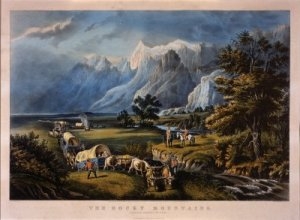May 11-July 30, 2005
The Western Pursuit of the American Dream:
Selections from the Collection of Kenneth W. Rendell
 Rich in natural resources, cultures, legends and opportunities, the American West has made dreamers of generations of Americans. On view at the Grolier Club from May 11 through July 30, 2005, the exhibition The Western Pursuit of the American Dream chronicles the vast historical panorama of the American West through the outstanding holdings of collector Kenneth W. Rendell. Nearly 150 objects document this national adventure through the actual words and artifacts of explorers, travelers, warriors, gold seekers, merchants, outlaws-dreamers all-who shaped the American frontier.
Rich in natural resources, cultures, legends and opportunities, the American West has made dreamers of generations of Americans. On view at the Grolier Club from May 11 through July 30, 2005, the exhibition The Western Pursuit of the American Dream chronicles the vast historical panorama of the American West through the outstanding holdings of collector Kenneth W. Rendell. Nearly 150 objects document this national adventure through the actual words and artifacts of explorers, travelers, warriors, gold seekers, merchants, outlaws-dreamers all-who shaped the American frontier.
The Western Pursuit begins with the Spanish in Mexico and ends with filmmakers in Hollywood. It chronicles the dream of freedom and opportunity in the West and how it inspired adventures, trade, and legends, exploring the history of the fur trade, cartography, industry, artistry, and Western tourism. The Rendell collection includes fascinating letters, diaries and first-hand descriptions, as well as intriguing western artifacts collected over decades. Rarely-seen volumes such as a first edition of the History of the Expedition…of Captains Lewis and Clark, and personal accounts by explorers, traders, trappers, and travelers provide an intimate glimpse of the West. Its history is also conveyed through remarkable artifacts such as a gold pan used by forty-niners, letters of Davy Crockett and Wild Bill Hickok, Pony Express envelopes, and Frank James' playing cards. As Mr. Rendell has pointed out, "These remnants of the past express, as no historian can, the realities, anxieties, and hope of a new life that the West represented. This sense of hope was not exclusive to the people who actually went there, but was also felt by those who merely fantasized about escaping to the frontier."
The trek by Meriwether Lewis, William Clark and their Corps of Discovery is one of America's legendary adventures. Silver peace medals like those used by Lewis and Clark to gain the trust of Indian leaders are on view. An extraordinarily rare, first-edition map of Lewis and Clark's journey, which portrayed far more territory than anticipated and further fueled the lure of the West, is an exhibition highlight.
In the 1840s, the era of Manifest Destiny, Americans were consumed with dreams of settling the West. This period is recalled through a fascinating selection of guidebooks used by travelers to cross the continent. Publications like The Route Across the Rocky Mountains (1846) and A New History of Oregon and California (1847) present a first-hand look at the great overland migration. Miners soon followed and the story of the California gold rush is told through evocative early photographs of miners, panning equipment, travel guides, gold nuggets, and a rare letter by John A. Sutter---all evoking the dream of striking it rich in places where the streets were purportedly paved in gold.
Others found ways to earn a living in the West. Soon after the Civil War, industrialization spread with the transcontinental railroad. Within two years of its completion in 1869, passengers and freight could cross the continent in a matter of days. Stereograph images from events like the Golden Spike Ceremony, and the idealized prints of railroad travel by Currier and Ives fueled enthusiasm for many to pursue opportunity in the West.
The exhibition also reveals the tensions between the romance and the realities of the West, as Davy Crockett stories and tales of cowboys often portrayed an idealized view. Even lore of the infamous outlaw Jesse James depicts a complex character that was both admired and loathed in his day, while the legendary Pony Express is shown to have been a short-lived venture that operated for only 18 months. Similarly, the widespread public fascination in the 19th century with Native American culture and artifacts, even as the U.S. government worked to eradicate traditional Indian communities, is examined.
The Western Pursuit concludes with a look at how the history of the West was further codified in the twentieth century by Hollywood film studios. "It is important to remember that the people presented in this exhibition were dreamers," said Mr. Rendell. "In fact, the American West still inspires modern-day dreams in industry, education, and business. This is the story of the pursuit of dreams. You could say it is the story of human nature itself."
The Western Pursuit of the American Dream originated at the Museum of Our National Heritage in Lexington, MA, and is accompanied by a fully-illustrated, color catalogue available for $39.95 at the Grolier Club.